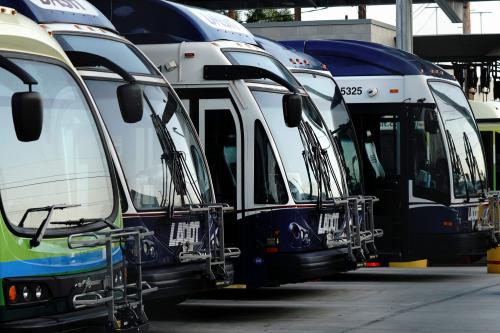The Infrastructure Investment and Jobs Act (IIJA) offers an unprecedented opportunity to accelerate momentum around careers that pay higher wages, require shorter-term credentials, and need a new generation of talent. As millions of workers around the country struggle, leaders need to be ready to harness this funding in ways that expand opportunities to the full diversity of our workforce—women and men, the unemployed and underemployed, and younger students and adult learners.
A recent event held by Brookings Metro and the Council for Adult and Experiential Learning (CAEL) explored strategies to do just that. It featured insights from those who will have to do a lot of the heavy lifting: employers, workforce development leaders, economic development officials, and many others at the local, state, and federal level.
As event participants discussed, the IIJA is an economic down payment to support lasting growth. Alongside other pending federal legislation, it not only has the potential to accelerate historic investments in transportation, water, energy, broadband, and other systemwide improvements, but it is also shining light on what we must achieve for the infrastructure workforce in the months and years to come. That’s particularly true when it comes to climate-focused jobs such as those in renewable energy and electric vehicles. However, simply throwing more money at infrastructure and climate improvements is no guarantee that training investments and high-quality job opportunities will be accessible to all people and all places.
Federal, state, and local leaders who collectively own and operate these systems must better coordinate to maximize the reach of this funding. This is an opportunity for short-term growth, and more importantly, for longer-term growth in both our local economies and individual economic mobility. We are in a crucial implementation phase where we can’t just pay lip service to infrastructure’s economic potential—we need to maximize infrastructure’s economic impact. If transportation departments, water utilities, and other IIJA-eligible entities do not find and train enough workers—and soon—we risk squandering this opportunity.
To start, we need to better define that opportunity. Too often, policymakers, researchers, and other leaders focus on a bean-counting exercise: trying to calculate the precise number of “shovel-ready” or “green” jobs. They also tend to overemphasize a narrow range of activities and work tasks, usually involved in short-term construction. We need to take a step back and recognize which workers are going to fill a broad range of occupations involved in construction, maintenance, and design. Previous Brookings research has shown that more than three-quarters of these jobs are involved in the long-term operation of a facility or company, from engineers to electricians to technicians, as well as other service positions involved in finance, IT, and human resources. In other words, you don’t have to wear a hard hat to pursue an infrastructure career; the job opportunities that are buoyed by infrastructure investments are much broader than many discussions might suggest.
We also need to better describe the challenge. Many of these jobs pay more competitive and equitable wages compared to all jobs nationally, and demonstrating the skills they require can often be done in ways that don’t neglect those who lack the formal educational barriers to entry. Around half (53.4%) of infrastructure workers have a high school diploma or less, compared to around a third (31.7%) of all workers nationally. Still, other barriers stop many workers from these careers; for example, women currently fill less than 20% of these jobs, and people of color remain underrepresented as well. Overcoming this challenge is crucial since many current workers in the skilled trades and other infrastructure positions are aging and retiring, leading to huge gaps that must be filled.
As featured in the Brookings-CAEL event, it will take the combined efforts of multiple regional and national leaders to harness IIJA funding in ways that reach more and different types of workers, specifically by focusing on:
- Investing in training, upskilling, and reskilling. Event attendees identified “challenges around training and education” as their top concern about the infrastructure workforce. That includes preparing younger workers as well as older and other nontraditional workers looking to transition into these careers. To meet our skill needs quickly, one of our best bets is apprenticeship and other work-based learning models that bring workers up to speed while offering them paid employment. Betony Jones, senior advisor at the Department of Energy, noted the important role that labor unions have played in upskilling the incumbent workforce, and the Department’s Artificial Intelligence and Technology Office is looking at how to incorporate virtual reality into training and the importance of sharing that kind of emerging technology with training providers and labor unions as the nature of work evolves in the infrastructure space.
- Increasing the diversity of the infrastructure workforce. This will take a multipronged approach, including a communications strategy targeted to both current job seekers and the future workforce. Sharing one employer’s perspective, NextEra Energy’s James Auld explained that concern for the longer-term talent pipeline has prompted the company to invest in programs in middle schools. Betony Jones pointed to the Department of Energy’s partnerships with historically Black colleges and universities as well as labor unions. Arlen Herrell from Washington, D.C.’s Department of Employment Services spoke to the importance of providing trainee stipends and working directly with employers to expand their talent pipelines. And SeonAh Kendall, senior economic manager for Fort Collins, Colo., added that having greater diversity among instructors could also go a long way toward including individuals from populations that have been traditionally overlooked and marginalized in certain occupations.
- Reducing barriers to innovation and better coordinating programs among federal agencies and state and local leaders. Both attendees and panelists at our event were excited about the workforce development opportunities created by new federal funding streams, but also noted how challenging those dollars can be. Program designers need to consider the administrative burdens, particularly for smaller employers, as well as the regulatory restrictions that can limit opportunities for innovation. As these programs are implemented, federal administrators also need to coordinate their efforts—around climate and equity, for instance—with those at the local and state level so that the work on the ground can proceed unimpeded.
These issues only scratch the surface of what federal, state, and local leaders need to do around infrastructure workforce development amid an influx of new funding. The infrastructure talent pipeline is increasingly empty, and the lack of skilled workers may pose challenges to getting projects done. These workforce gaps could also very likely reduce the impact of IIJA funding and hold back benefits for communities over time.
But as conversations evolve among these leaders in the coming months, they have an opportunity to further refine and test potential applications of this generational funding—to not simply reinforce existing and inequitable workforce gaps, but to create stronger pathways for all prospective workers, including those underrepresented in infrastructure and infrastructure-adjacent occupations. Doing so has the potential to expand economic opportunity well beyond the IIJA’s initial launch and into years to come.
The Brookings Institution is committed to quality, independence, and impact.
We are supported by a diverse array of funders. In line with our values and policies, each Brookings publication represents the sole views of its author(s).








Commentary
Harnessing the Infrastructure Investment and Jobs Act to train the next generation of workers
February 23, 2022